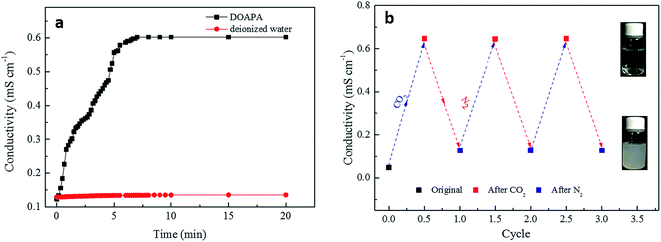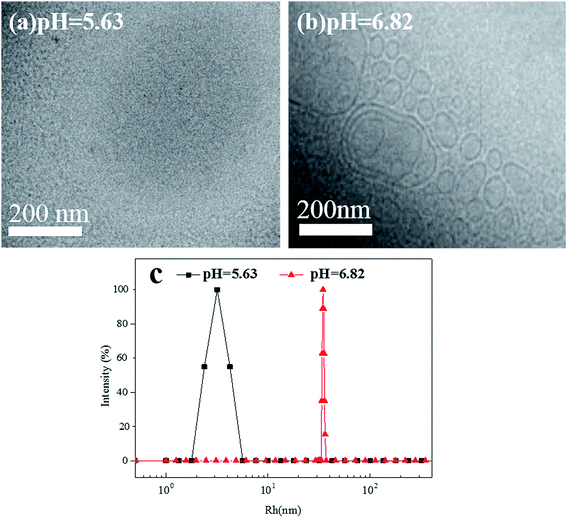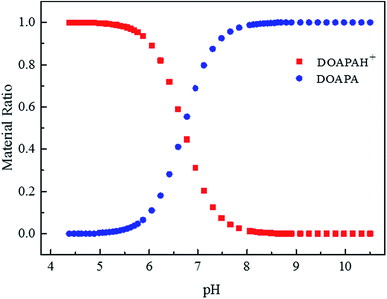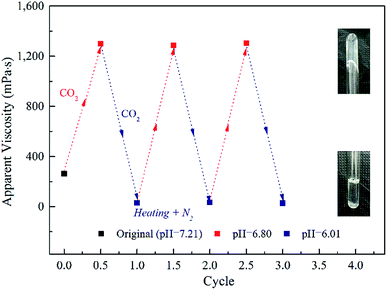Endowing a cationic hydrophobic associating polyacrylamide solution with CO2 switchable properties using N,N-dimethylolamidopropylamine via the assembly transition between vesicles and spherical micelles by CO2†
Hongsheng Lu*a,
Cunchuan Zhenga,
Li Wangb,
Ya Liua and
Zhiyu Huanga
aCollege of Chemistry and Chemical Engineering, Southwest Petroleum University, Chengdu 610500, P. R. China. E-mail: hshlu@swpu.edu.cn; Fax: +86-28-83037330; Tel: +86-28-83037330
bSichuan Institute of Fine Chemical Industry Research and Design, Chengdu 610500, P. R. China
First published on 1st November 2016
Abstract
Carbon dioxide triggers have attracted much attention due to their low cost, non-toxicity, simplicity and environmental benignity. N,N-dimethylolamidopropylamine (DOAPA) is a CO2 switchable surfactant, the properties of which can be regulated by CO2 easily. A mixture of a cationic hydrophobic associating polymer (PAD) and the CO2 switchable DOAPA was prepared, which endowed the non-switchable PAD solution with CO2 switchable properties. Then the viscosity and rheology behaviors of the solution were investigated under different pH conditions, with or without CO2. The PAD–DOAPA mixture can be stimulated by CO2 to alter the viscosity of the solution dramatically, with DOAPA assembled as vesicles at a pH of 6.8, and with a water-like viscosity at a pH of 6.0. The reversible transitions of micelle structure and viscosity can be recycled several times through the bubbling and removal of CO2. Most important of all, the viscosity of the PAD–DOAPA system increased over time, which is different from the usual hydrophobic associating polymer–surfactant system, in which the viscosity has a maximum which decreases with further surfactant addition, due to the assembly of DOAPA into vesicles. Finally, a reasonable mechanism is proposed, based on the molecular structures, micelle assembly and intermolecular interactions. Upon the removal of CO2, the assembled form of DOAPA changed from vesicles to spherical micelles, which shielded the hydrophobes and dissociated the gel into a sol. PAD–DOAPA aqueous systems with CO2-reversible properties have wide applications in the fields of oil and gas production.
1 Introduction
Hydrophobic associating polymers or hydrophobic modified polymers are prepared with hydrophobic monomers (<2 mol%) on a polymer backbone, leading the polymer solutions to possess high viscosities even at lower concentrations, due to the inter-molecular associations of the hydrophobic units.1 Therefore, hydrophobic associating polymers have become the object of extensive research because of their peculiar rheological features.2–11In recent years, hydrophobic associating polymer–surfactant systems have inspired widespread interest, because the properties of the hydrophobic associating polymer solutions can be markedly affected by the addition of a few surfactants. McCormick12 employed three different kinds of charge character surfactants to discuss the effects of surfactants on a cationic hydrophobic associating polymer, in the presence of non-ionic (Triton X-100), anionic (sodium dodecyl sulfate (SDS)) and cationic (dodecyltrimethylammonium bromide (DTAB)) surfactants. There was little effect of the non-ionic surfactant on the hydrophobic associating polymer. However, the addition of the cationic surfactant caused a significant decrease in the viscosity of the solution. The solution exhibited a completely different viscosity behavior with the addition of SDS, whereby the viscosity increased markedly and reached a maximum, followed by a rapid decrease at higher surfactant concentrations. When the concentration of SDS was below the CMC, mixed micelles were formed from the hydrophobes and the SDS, in which the hydrophobic groups belong to two or more distinct polymer chains. Therefore, intermolecular bridging resulted in a viscosity maximum. Upon further increase of surfactant concentration, the hydrophobic groups were shielded by the surfactant, which led to the collapse of the polymer chains, and the network structure was destroyed.
However, research on hydrophobic modified polymers in the presence of surfactants has mostly focused on general surfactants and the assembly of spherical micelles13–15 and rod-like micelles.16 There are few interesting studies on alternative assemblies and stimuli-responsive surfactants.
Recently, switchable surfactants have attracted the attention of many researchers due to their excellent reversible responses to external changes such as pH,17–19 temperature20 and CO2.21–24 Furthermore, carbon dioxide triggers have attracted a lot of attention due to their low cost, non-toxicity, simplicity and environmental benignity.21 In 2006, Jessop25 reported a kind of surfactant which can be reversibly switched “on” and “off” by the addition and removal of CO2. Many CO2 switchable surfactants have since been reported.26–30
N,N-dimethylolamidopropylamine is a CO2 switchable surfactant, the properties of which can be easily regulated by CO2. The structure of the self-assembled DOAPA can change from vesicles to spherical micelles as the pH changes from 6.8 to 6.0. In this work, we developed a mixture composed of a cationic hydrophobic associating polymer (PAD) and DOAPA. The mixture of PAD and DOAPA can be stimulated by CO2 to form a viscoelastic fluid when the DOAPA is assembled into vesicles at a pH of 6.8, followed by a change to a water-like fluid after CO2 removal. The reversible transitions of the micelle structure and the viscosity can be recycled several times through the bubbling and removal of CO2. The switchable properties of DOAPA and the assembly of DOAPA at different pH conditions are discussed. Moreover, the properties of the mixture of PAD and DOAPA were investigated, including its switchable properties and viscoelastic properties. Finally, a reasonable mechanism is proposed based on the molecular structures, micelle assembly and intermolecular interactions. PAD–DOAPA aqueous systems with CO2-reversible properties and sol–gel transitions have wide applications in various fields.
2 Experimental section
2.1 Materials
N,N-dimethylolamidopropylamine and N,N′-dimethyl octadecyl allyl ammonium chloride were synthesized in our laboratory and reported elsewhere.31 Acrylamide and ethanol of analytical grade were purchased from Kelong Chemical Co., Ltd (China). 2,2′-Aziobisisobutyronitrile (V-50) was purchased from Sigma Aldrich Chemicals and stored at −10 °C.2.2 Preparation of PAD
The hydrophobic associating polymer PAD was prepared by a previously reported method.32 In this work, the monomer solution included AM (acrylamide) (0.13 mol), N,N′-dimethyl octadecyl allyl ammonium chloride (0.696 mmol) and 40 mL deionized water. The reaction was carried out at 45 °C for 8 h after bubbling with N2 for 30 minutes and the addition of the initiator V-50 (0.5 mg). Finally, the products were precipitated and washed with ethanol, then the products were dried in a vacuum oven at 50 °C for 24 h.2.3 Characterization and measurements
Protonation constants (pKa) of DOAPA were measured using a titrator (Metrohm 888 Titrando, China) at a temperature of 25 °C. Generally, NaOH standard solution (0.10 M) was added to 10 mL of DOAPA aqueous solution (2 mM) until the pH was about 11.0, followed by a subsequent titration with HCl standard solution (0.10 M) until the pH was 4.0.The diameter distributions were tested with dynamic light scattering equipment (BI-200SM, USA) at a temperature of 25 °C, a scattering angle of 90° and a laser wavelength of 532 nm. The prepared polymer solutions were filtered through a 0.45 μm MICRO PES membrane before the measurements were carried out.
The microstructure of the hydrogel was analysed with an environmental scanning electron microscope (Quanta) below 0 °C. The samples were injected into liquid N2 before testing. Cryogenic transmission electron microscopy (Cryo-TEM) measurements were carried out with a JEM2010 Cryo-microscope at −174 °C.
The rheological properties of the samples were analysed with a Malvern CVOR-200 Rheometer at a temperature of 25 °C. After the linear viscoelastic region was determined, the dynamic oscillatory data was collected.
3 Results and discussion
3.1 CO2 switchable properties of DOAPA
There is a pH-sensitive tertiary amine group in DOAPA that can be protonated to a cationic state (DOAPAH+) when CO2 is bubbled into the solution, forming ammonium bicarbonate. Thus, DOAPA can dissolve in the solution, leading to increased conductivity and decreased surface tension.As shown in Fig. 1a, the conductivity of the DOAPA solution increased to a maximum value after several minutes as CO2 was bubbled into the solution. For comparison, the conductivity of deionized water alone was also measured and the conductivity was consistent. This indicates that DOAPA can be easily protonated to its cationic state (DOAPAH+), resulting in decreased conductivity.
 | ||
| Fig. 1 (a) Conductivity curves upon bubbling with CO2 and (b) conductivity during repeated bubbling with CO2 and N2 of a 20 mM DOAPA solution at 25 °C. | ||
However, the protonation process is a reversible reaction and the formation of ammonium bicarbonate is not steady (Scheme 1). When N2 was bubbled into the DOAPAH+ solution, dissolved CO2 was discharged, leading to the equilibrium shifting to the left until the DOAPA was precipitated from the solution. This process can be reversible and is repeated when CO2 and N2 is cyclically bubbled. This indicates that the properties of DOAPA can be regulated with CO2 and N2.
3.2 The distribution and assembly of DOAPA
DOAPA can be protonated to its cationic surfactant form under acidic conditions and exhibits a different state under nearly neutral conditions. Therefore, it is necessary to know the composition of DOAPA at different pH values. The pH titration curves for DOAPA are shown in Fig. 2.DOAPA was protonated to its bicarbonate form (DOAPAH+·HCO3−) when CO2 was bubbled into the solution. The cationic surfactant DOAPAH+ comprised fifty percent of the total mixture at a pH of 6.8. That is to say that half of the DOAPA changed to DOAPAH+ and the other half was non-protonated. Under these conditions, the self-assembled DOAPA was present as plenty of vesicles according to the Cryo-TEM image (Fig. 3a).
Upon further bubbling of CO2 into the solution, more DOAPA changed to DOAPAH+, and DOAPA almost entirely changed to DOAPAH+ at a pH of 5.6. Under these conditions, the self-assembled DOAPA changed from vesicles to spherical micelles.
 | ||
| Fig. 3 Cryo-TEM images of 20 mM DOAPA at pHs of (a) 5.63 and (b) 6.82, respectively. (c) DLS curves of 20 mM DOAPA at pHs of 5.63 and 6.82. | ||
The sample was further studied by DLS, as shown in Fig. 3c. The size of the self-assembled DOAPA was about 20–40 nm at a pH of 6.8, which was much bigger than that at a pH of 5.6 (about 2–7 nm). This indicated that the self-assembled DOAPA was in the form of vesicles at a pH of 6.8 and spherical micelles at a pH of 5.6, as shown in Scheme 2. This result was obtained in accordance with the results of the Cryo-TEM.
3.3 The effect of DOAPA on the PAD solution
The solution properties of the hydrophobic associating polymer can be dramatically affected by the addition of surfactant. Fig. 4a illustrates the viscosity behavior of PAD in the presence of DOAPA at different pH values. A continuous decrease in the viscosity of the PAD solution was observed with increasing concentrations of DOAPA at a pH value of 5.4. Under these conditions, DOAPA was almost entirely protonated to the cationic surfactant, with the same charge as the hydrophobes, which can enhance the repulsive force between the hydrophobes and increase the ionic strength of the solution, leading to a decrease in the hydrophobic associating strength and the viscosity.In contrast, the copolymer solutions exhibited completely different viscosity behaviors at a pH of 6.8. The viscosity of the PAD solution increased markedly when the DOAPA concentration was below 10 mM, and then increased slowly with further increase in DOAPA concentration. Under these conditions, the structures of the self-assembled DOAPA in this mixed system were observed as plenty of vesicles, which mixed with the hydrophobic group of the PAD to form mixed vesicles containing two or more distinct polymer chains. The mixed vesicles resulted in increased viscosity due to intermolecular bridging. The viscosity of the cationic polymer PAD increased with the addition of cationic surfactant, which was different from the usual hydrophobic associating polymer–surfactant system, in which the viscosity decreased with surfactant addition when the surfactant had the same kind of charge as the hydrophobes.
The viscosity increased slowly with further increase in DOAPA concentration due to the limited hydrophobic groups on the PAD. The viscosity increased with increased concentration, which was also different from the usual hydrophobic associating polymer–surfactant system, in which the viscosity reached a maximum and then decreased upon further surfactant addition. This may be because the additive DOAPA mixed with the vesicles to form bigger vesicles and so few new vesicles were generated upon further addition of the surfactant.
The viscoelasticity of the PAD–DOAPA mixture was also investigated with different DOAPA concentrations at a pH of 6.8 and the result is depicted in Fig. 4b. The elastic modulus G′ and viscous modulus G′′ both increased with the frequency over the whole range from 0.01 to 10 rad s−1. The elastic modulus G′ and viscous modulus G′′ decreased with increasing DOAPA concentration. For the DOAPA solution with a concentration of 5 mM, the elastic modulus G′ was larger than the viscous modulus G′′ over the whole range and there was no intersection point. However, the elastic modulus (G′) crosses over the viscous modulus (G′′) when exceeding a critical frequency (ωc) of around 0.056 rad s−1 and 5 rad s−1, when the DOAPA concentration increased to 10 mM and 20 mM, respectively. In other words, the solutions are present as typical elastic fluids at high frequencies, while they exhibit evident viscous behavior at low frequencies. The relaxation time τR(∼1/ωc) was finite for the sample with a DOAPA concentration of 5 mM and the relaxation time decreased with increasing DOAPA concentration.
The viscoelastic features indicate that the strength of the hydrogel reduced with the addition of DOAPA with concentrations above 5 mM. This is because there are not only association effects but also repulsive forces between DOAPAH+ and the hydrophobes, due to the hydrophobes and DOAPAH+ possessing the same kind of charge.
3.4 Switchable properties of the PAD–DOAPA mixture
The steady shear rate and viscoelasticity of the mixture were also investigated at pHs of 6.82 and 6.01. As presented in Fig. 5a, at a pH of 6.01, the aqueous solution exhibited Newtonian fluid behaviour. However, the sample presented obvious shear-thinning behavior at a pH of 6.82, with a plateau in viscosity at low shear rates and a linear decrease in viscosity at higher shear rates, inferring viscoelastic fluid behaviour. | ||
| Fig. 5 (a) Steady shear rate and (b) dynamic viscoelasticity of DOAPA–PAD at different pHs, the concentrations of DOAPA and PAD were 5 mM and 0.6 wt%, respectively. | ||
Dynamic rheology analysis was carried out and the results are shown in Fig. 5b. The elastic modulus G′ and viscous modulus G′′ at a pH of 6.8 were superior to those of the solution at a pH of 6.0. Furthermore, the elastic modulus G′ was above the viscous modulus G′′ over the whole range and there was no intersection point for the solution at a pH of 6.8, which indicated that the fluid was viscoelastic. However, the elastic modulus G′ was below the viscous modulus G′′ over the whole range at a pH of 6.0, inferring a viscosity responsive fluid. This result was found to be in accordance with the feature of the steady shear properties.
As shown in Fig. 6, the viscosity of the PAD–DOAPA mixture solution can be repeatedly and reversibly switched upon CO2 addition and removal from the solution. The pH of the mixture solution was 7.21 after adding DOAPA and the viscosity of the mixture solution was about 200 mPa s, which was the original viscosity of the hydrophobic associating polymer. With the introduction of CO2, the pH value decreased and the viscosity rapidly increased. The viscosity jumped up to a maximum of 1400 mPa s at a pH of 6.8, which was a magnitude greater than that of the solution without CO2. With the further addition of CO2, however, the viscosity of the mixture solution significantly decreased and was even below the original viscosity of the solution, which was because the assembled DOAPA had transformed from vesicles to spherical micelles and the DOAPAH+ had the same charge as PAD due to the complete protonation of DOAPAH+. When CO2 was displaced by N2, the viscosity of the solution recovered to its initial value. Furthermore, such changes can be easily cycled several times without any deterioration.
3.5 The mechanism of the switchable transition
As shown in Fig. 7a–d, it was clearly found that the microstructure of the micelles translated from a vesicle form to a spherical micelle form when the pH was changed from 6.82 to 6.00 in both the DOAPA–PAD and DOAPA systems. Correspondingly, the Rh of DOAPA–PAD at a pH of 6.82 was much bigger than that at a pH of 6.00. Therefore, the gel was also destroyed with the transition of the pH from 6.82 to 6.00 as shown in Fig. 7e and f.As shown in Scheme 3, the sol–gel transitions, regulated by CO2 and N2, are summarized with simple illustrations. When the pH of the solution reached 6.8 as CO2 was bubbled into it, half of the DOAPA was protonated to its quaternary ammonium form, forming plenty of giant vesicles as shown in Fig. 7b. The vesicles can associate with the hydrophobes to form mixed vesicles. Therefore, the hydrophobic associating polymer was crosslinked by the mixed vesicles and the mixture solution presented a hydrogel network.
However, with the further introduction of CO2 and at a pH of 6.0, the DOAPA was completely protonated to the quaternary ammonium DOAPAH+, leading to a transition of the assembled DOAPAH+ from vesicles to spherical micelles. The spherical micelles were much smaller than the vesicles as presented in Fig. 3c, and therefore they can associate with only one polymer chain, causing the hydrophobes to be shielded by the DOAPAH+. Therefore, the network was dissociated as shown in Fig. 7f. It needs to be pointed out that the mixed solution can be repeatedly and reversibly switched when CO2 is repeatedly bubbled into and removed from the solution.
4 Conclusion
In this work, a CO2 switchable surfactant, N,N-dimethylolamidopropylamine (DOAPA), was designed. The conductivity and Cryo-TEM results revealed that the DOAPA can be protonated and deprotonated by CO2 and N2 respectively, and the states of the self-assembled DOAPA in solution changed from vesicles to spherical micelles as the pH varied from 6.8 to 6.0. A mixture was developed with the cationic hydrophobic associating polymer PAD and the CO2 switchable surfactant DOAPA, which led to a non-switchable PAD solution with CO2 switchable properties. The mixture of PAD–DOAPA can be stimulated by CO2 to change the viscosity of the solution dramatically, with the DOAPA assembled as vesicles at a pH of 6.8, and with the solution flowing like water at a pH of 6.0. The viscosity of the cationic polymer PAD increased with the addition of the cationic surfactant, which was different from the behaviour of the usual hydrophobic associating polymer–surfactant system, in which the viscosity decreases with surfactant addition when the surfactant has the same kind of charge as the hydrophobes. The reversible transition between a viscoelastic and water-like fluid can be achieved several times by the alternate addition and removal of CO2. Finally, a reasonable mechanism was proposed, based on the molecular structures, micelle assembly and intermolecular interactions; The DOAPA is protonated to form plenty of giant vesicles as intermolecular bridges crosslink the hydrophobic associating polymer at a pH of 6.8. With addition of N2, the assembled form of DOAPA changed from vesicles to spherical micelles, which shielded the hydrophobes, thus dissociating the gel to a sol. The PAD–DOAPA hydrogel with a CO2-reversible sol–gel transition has great potential applications in oil and gas production.Acknowledgements
This work was supported by the National Natural Science Foundation of China (No. 21403173) and the Scientific Research Innovation Team Project of Provincial Universities in Sichuan Province (No. 2013TD0025).Notes and references
- Y. Feng, L. Billon, B. Grassl, G. Bastiat, O. Borisov and J. François, Polymer, 2005, 46, 9283–9295 CrossRef CAS.
- V. Castelletto, I. W. Hamley, W. Xue, C. Sommer, J. S. Pedersen and P. D. Olmsted, Macromolecules, 2004, 37, 1492–1501 CrossRef CAS.
- C. Rufier, A. Collet, M. Viguier, J. Oberdisse and S. Mora, Macromolecules, 2009, 42, 5226–5235 CrossRef CAS.
- D. Hourdet, G. Ducouret, S. Varghese, M. V. Badiger and P. P. Wadgaonkar, Polymer, 2013, 54, 2676–2689 CrossRef CAS.
- I. Kaneda, T. Koga and F. Tanaka, Rheol. Acta, 2012, 51, 89–96 CrossRef CAS.
- B. Nyström, A. Kjøniksen, N. Beheshti, K. Zhu and K. D. Knudsen, Soft Matter, 2009, 5, 1328 RSC.
- H. Zheng, Y. Sun, C. Zhu, J. Guo, C. Zhao, Y. Liao and Q. Guan, Chem. Eng. J., 2013, 234, 318–326 CrossRef CAS.
- E. V. Korchagina and O. E. Philippova, Langmuir, 2012, 28, 7880–7888 CrossRef CAS PubMed.
- X. Chen, Y. Wang and R. Pelton, Langmuir, 2005, 21, 11673–11677 CrossRef CAS PubMed.
- J. A. Shashkina, O. E. Philippova, Y. D. Zaroslov, A. R. Khokhlov, T. A. Pryakhina and I. V. Blagodatskikh, Langmuir, 2005, 21, 1524–1530 CrossRef CAS PubMed.
- D. T. Auguste, J. Kirkwood, J. Kohn, G. G. Fuller and R. K. Prud’Homme, Langmuir, 2008, 24, 4056–4064 CrossRef CAS PubMed.
- Y. C. A. C. McCormick, Polymer, 1994, 35, 3503–3512 CrossRef.
- Y. Lin, Y. Qiao, X. Cheng, Y. Yan, Z. Li and J. Huang, J. Colloid Interface Sci., 2012, 369, 238–244 CrossRef CAS PubMed.
- J. S. A. F. S. Biggs, Langmuir, 1992, 8, 838–847 CrossRef.
- F. K. H. B. Hilde Molvig Kopperud, Macromol. Chem. Phys., 1998, 199, 2385–2394 CrossRef.
- S. Panmai, R. K. Prud’Homme and D. G. Peiffer, Colloids Surf., A, 1999, 147, 3–15 CrossRef CAS.
- S. P. Nunes, A. R. Behzad, B. Hooghan, R. Sougrat, M. Karunakaran, N. Pradeep, U. Vainio and K. Peinemann, ACS Nano, 2011, 5, 3516–3522 CrossRef CAS PubMed.
- Z. Chu and Y. Feng, Chem. Commun., 2010, 46, 9028 RSC.
- G. Verma, V. K. Aswal and P. Hassan, Soft Matter, 2009, 5, 2919 RSC.
- Z. Chu and Y. Feng, Chem. Commun., 2011, 47, 7191 RSC.
- X. Su, M. F. Cunningham and P. G. Jessop, Chem. Commun., 2013, 49, 2655 RSC.
- Y. Zhang, Y. Feng, J. Wang, S. He, Z. Guo, Z. Chu and C. A. Dreiss, Chem. Commun., 2013, 49, 4902 RSC.
- Y. Zhang, H. Yin and Y. Feng, Green Mater., 2014, 2, 95–103 CrossRef.
- Y. Zhang, Y. Feng, Y. Wang and X. Li, Langmuir, 2013, 29, 4187–4192 CrossRef CAS PubMed.
- Y. Liu, P. G. Jessop, M. Cunningham, C. A. Eckert and C. L. Liotta, Science, 2006, 313, 954–958 CrossRef PubMed.
- A. S. M. M. P. G. Jessop, Energy Environ. Sci., 2012, 5, 7240–7253 Search PubMed.
- T. Arthur, J. R. Harjani, L. Phan, P. G. Jessop and P. V. Hodson, Green Chem., 2012, 14, 357–362 RSC.
- A. B. Z. L. Dazhen Xiong, Green Chem., 2013, 15, 1941–1948 RSC.
- D. A. J. D. P. G. Jessop, Green Chem., 2012, 14, 1245–1259 RSC.
- P. G. Jessop, L. Kozycz, Z. G. Rahami, D. Schoenmakers, A. R. Boyd, D. Wechsler and A. M. Holland, Green Chem., 2011, 13, 619 RSC.
- H. Lu, L. Wang and Z. Huang, RSC. Adv., 2014, 4, 51519–51527 RSC.
- H. Lu, Y. Liu, B. Wang, C. Zheng and Z. Huang, Colloids Surf., A, 2016, 490, 1–8 CrossRef CAS.
Footnote |
| † Electronic supplementary information (ESI) available. See DOI: 10.1039/c6ra22878j |
| This journal is © The Royal Society of Chemistry 2016 |







